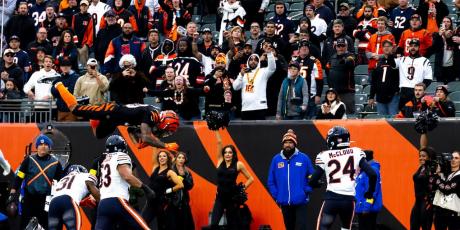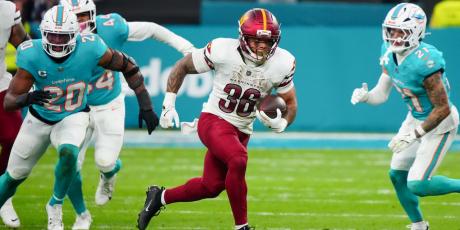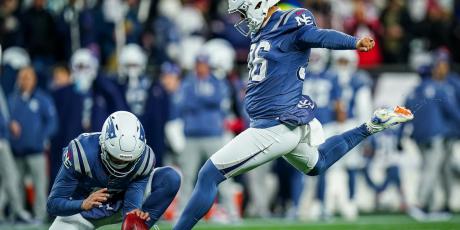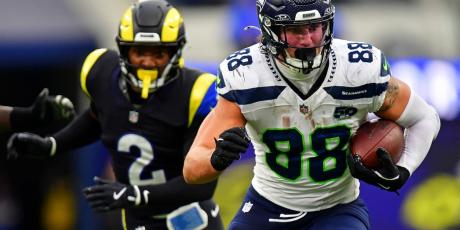Should We Use Dynasty ADP to Inform Redraft Decisions?

A couple of years ago, I did some research on whether the average draft position (ADP) for dynasty leagues was a better indicator of the upcoming season's player rankings than the ADP from redraft leagues. The logic behind this research is that we should (generally) be targeting players in our drafts that have the potential to rise up redraft boards in future years. Because, if they rise up redraft boards then they likely had a great fantasy year in the season prior.
But, when I did the research back then it was a fairly crude and fast version as the upcoming NFL season was right around the corner. Now, I'm equipped with more technical skills (and time) to complete a more in-depth review of comparing dynasty and redraft ADP to final player scoring ranks.
This article will explore whether dynasty or redraft ADP is a better predictor of end-of-year fantasy point rankings. In my research, I evaluated different positions and positional groups to see if there are any positional differences. Furthermore, since fantasy football draft season lasts several months, I also split the data by various points in the offseason.
Methodology
Before I get into the details, I want to share some assumptions I made and details about the data. I removed players who ended up not playing in a season, whether due to injury or something else. ADP is generally a good predictor of performance, but we'll never be able to predict season-ending injuries in the preseason. The data that I used goes back to the 2019 season.
Additionally, for this study, I used ADP and scoring data from FFPC dynasty and redraft best ball leagues. I used FFPC average draft position for two reasons. First, it offers ADP for both redraft and dynasty. I wanted to ensure that the source of the ADP came from the same place. Second, FFPC drafters are largely seen as sharp drafters due to the high-stakes nature of each league. The FFPC notably uses tight end-premium scoring (1.5 points per reception for tight ends), but my analysis takes this into consideration.
Finally, all the correlation numbers that you see are Spearman correlations, which is a correlation metric used specifically for rank-order variables. Since I will be evaluating ADP ranking (i.e., the fifth-highest drafted player based on ADP) and fantasy point rankings, this was the best method.
Now, enough of the boring stuff, let's get into the analysis.
Birds-eye view
I'm going to start off with a birds-eye view of data and zoom in from there. Below is a table that outlines the correlation between each position's dynasty and redraft ADP rank with their final positional ranking. Flex, in this scenario, includes running backs, wide receivers, and tight ends.
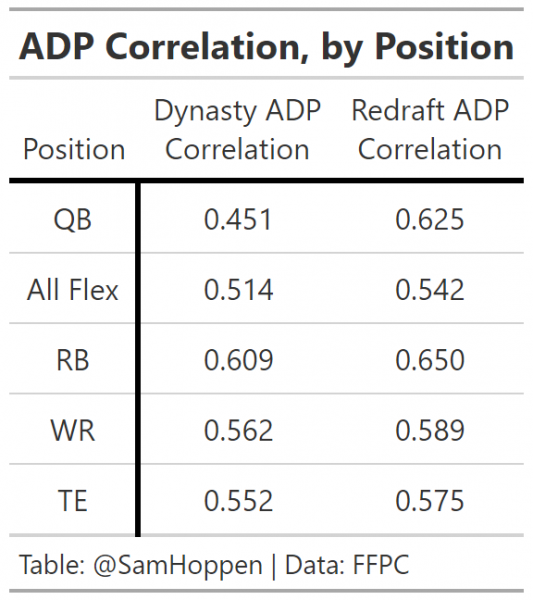
At first glance, redraft ADP is superior to dynasty ADP in predicting a season's final ranking. But, this barely scratches the surface of how to analyze the data. Next, I'll take a deeper dive into each position and how they compare individually.
Positional breakdown
In the following tables, I have broken down each position's correlation stats based on the month of the ADP because draft szn is more than just a month long. This can help give us a better comprehension of two things. First, we can understand when in the draft cycle ADP is most efficient and best at predicting future outcomes. Second, we can identify specific points in the year when dynasty ADP may be more useful than redraft ADP.
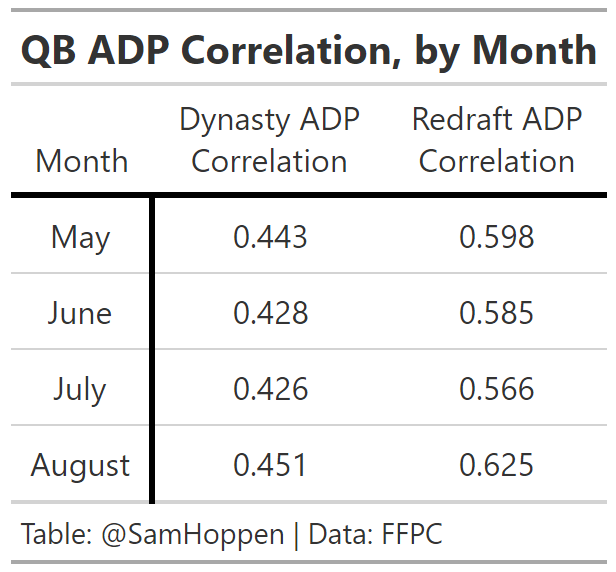
Starting off with the quarterback position, it is clear that dynasty ADP doesn't really do that much for us. Generally, this makes sense as dynasty ADP is going to favor rookie quarterbacks who may have a bright future, but who may not get a starting role right away. For example, last year Malik Willis - Tennessee's 3rd-round pick - was being drafted ahead of players like Mac Jones, Matt Ryan, and even Ryan Tannehill, all of whom were their team's starters heading into the season. It took an injury to Tannehill for Willis to even start a game, and even then he didn't perform great. This is a clear example of redraft players understanding the immediate future that starting quarterbacks have.
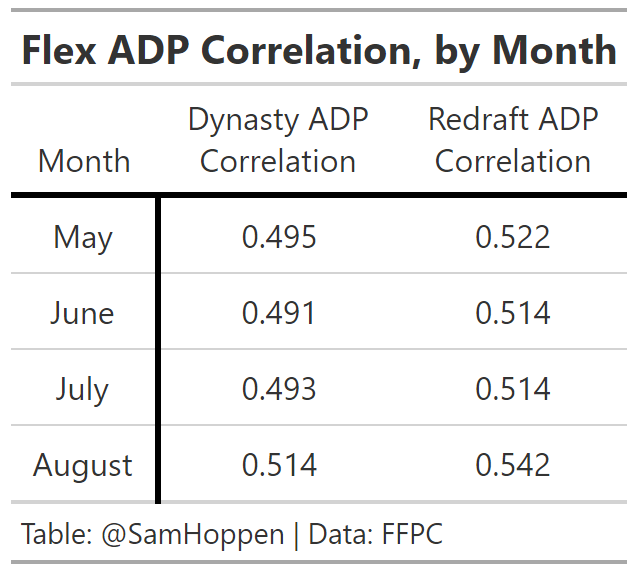
Next, I took a look at the same view, but for all flex positions combined. We see a much narrower gap between dynasty and redraft ADP here than with the quarterback position. Another trend that bears out is that we see the correlation rise as we move through the draft season. This is generally what we should expect with the data because, as the offseason rolls on, we get more information about positional battles, injuries, and more. Now, I will cover each of the flex positions individually.
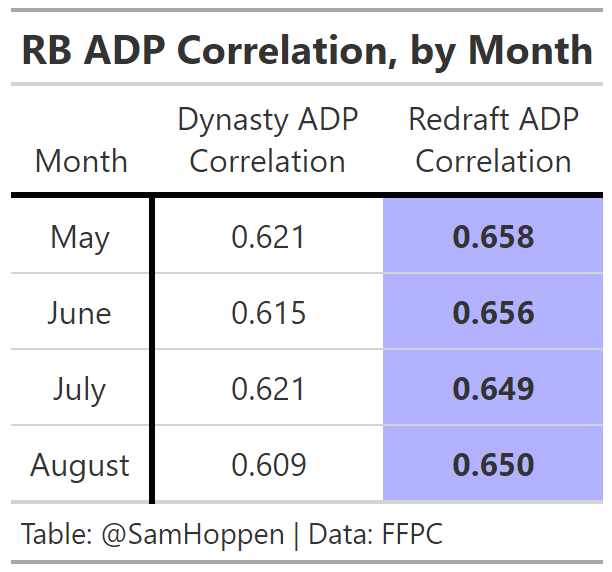
There aren't many surprises when it comes to the running back position. But, as I have highlighted, the redraft correlation in June and August for running backs is extremely high. In fact, among all of the numbers that I will show you in this article, they are among the two highest. My big takeaway with this is that the market does a really good job in pricing running back value. This would also suggest that the Zero-RB approach may not be as beneficial.
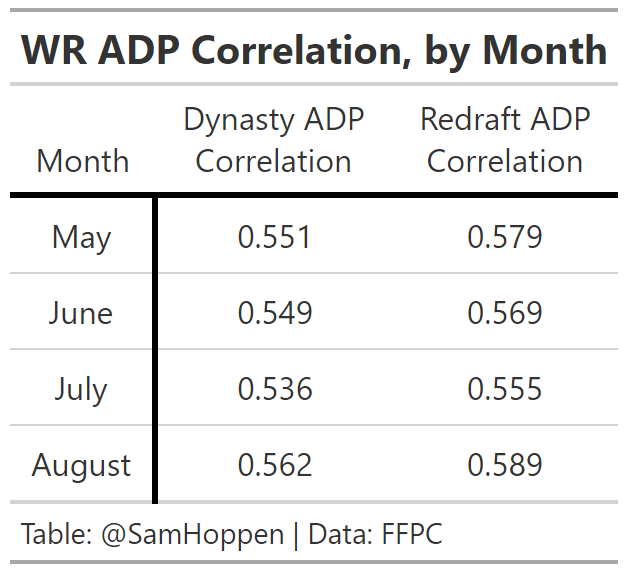
With wide receivers, the trends are quite similar and align with what we've seen already. It's small, but redraft still has a slight edge over dynasty ADP.
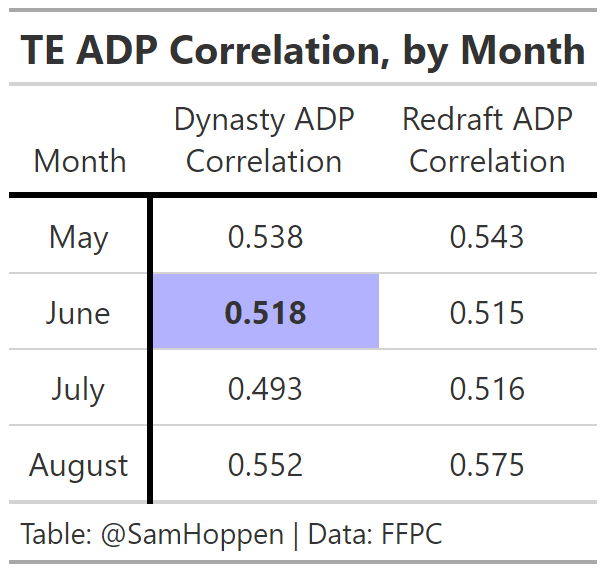
Tight end is where it gets interesting. In all of the previous calculations, redraft ADP had out-performed dynasty ADP, but here we see one instance (though by very little) of dynasty being a better indicator of upcoming-season performance. This actually shocks me quite a bit, for a couple of reasons. First, as I've mentioned, dynasty players often prioritize youth. However, tight ends notoriously take a few years to hit their prime. Since 2010, there have only been seven instances of a rookie tight end scoring at least 140 PPR points (enough to have cracked the top 12 in the position last year). Second, the tight end position, while historically top-heavy, often sees a lot of turnover within the year among the sub-elite players. It doesn't take much for a tight end to crack the top 12 in a season, which makes the swings slightly larger when a player has a couple of strong games.
To that end, all of the measurements I have done so far have been on the full set of players who have been drafted. But in fantasy football, we care most about drafting the best players. So, the next section will split each position up to see which is best at predicting fantasy's top players.
Predicting the Best
Again, I will start off by analyzing the quarterback position.
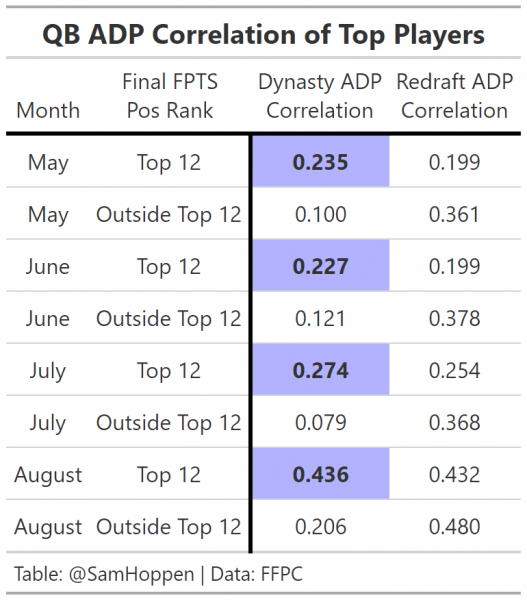
Well then! Here's another scenario in which dynasty ADP outperforms redraft ADP. You'll recall from earlier that quarterback had the widest gap between redraft and dynasty ADP (in favor of redraft), likely because of the impact that age has on where a player gets drafted. However, it is very rare to see those younger quarterbacks vault to the top of draft boards.
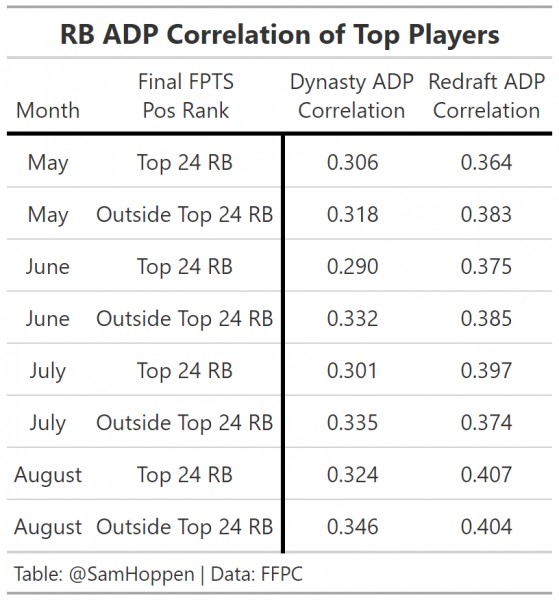
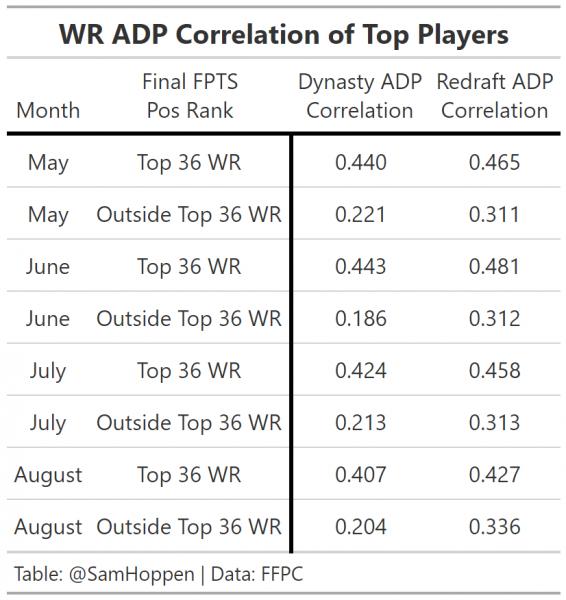
Unfortunately, the running back position nor the wide receiver position offers us much insight or trends that we can take advantage of. The tight end picture gives us something different, though.
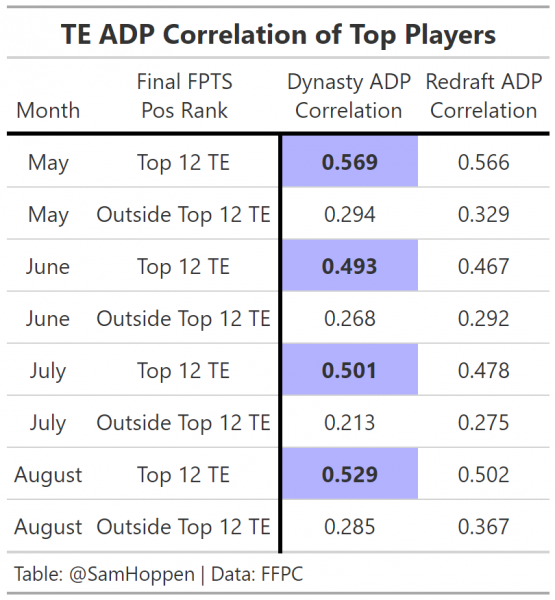
Finally, we once again see some situations in which dynasty ADP is favored in the tight end position. This shouldn't be all that surprising based on what we saw in the earlier graphic. That said, these edges are a bit more significant than what was shown in the previous graphic, which did not distinguish between where players finished.
Conclusion
One of the limitations that this analysis had is that it only used one source of ADP. If you draft on enough platforms, you will notice that there are major differences from one site to another. Whether it's because of the people who are drafting, the scoring system, or the type of league (tournament vs. regular redraft), players could be drafted rounds apart on various sites. So, there may be other platforms that offer even better (or worse) predictability in terms of their ADP.
In any case, average draft position remains a great predictor of future-season performances. It is a wisdom-of-the-crowds set of rankings that quickly adjust to player news and injuries while considering a plethora of other factors. However, it clearly works better in some situations than others. When considering whether to use dynasty ADP or redraft ADP in your draft decisions, redraft ADP is almost always the way to go. But, when drafting the onesie positions (quarterback and tight ends), you may want to break ties based on who has a higher dynasty ADP if you are between a couple of players.


